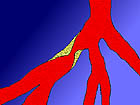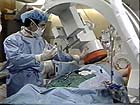The procedures and devices
in this section will describe what is known generically as "angioplasty",
a procedure first performed over 20 years ago by Andreas
Gruentzig, in his search for less invasive ways to treat
coronary artery disease. What he envisioned as an alternative
to open heart bypass surgery in perhaps 5% of cases, has
increased today to over 50%. (![]() See
a video clip about the first coronary angioplasty.)
See
a video clip about the first coronary angioplasty.)

|
|
||||||||||||||||

